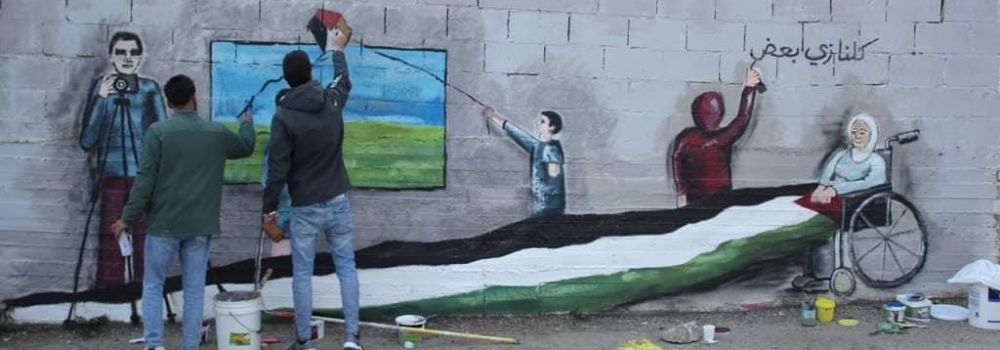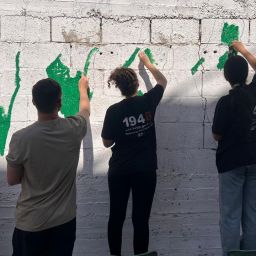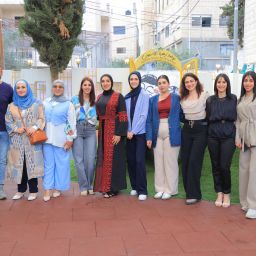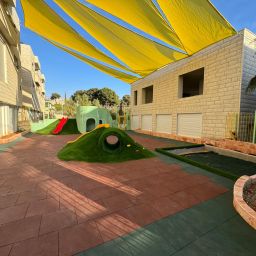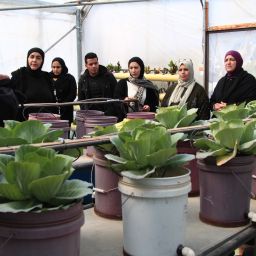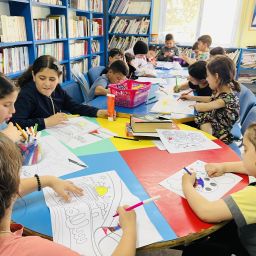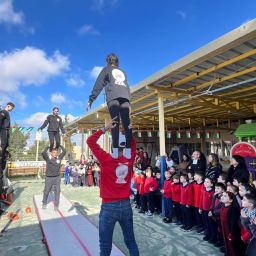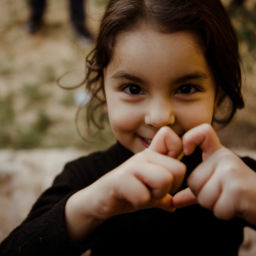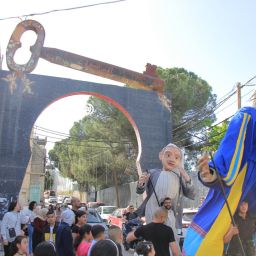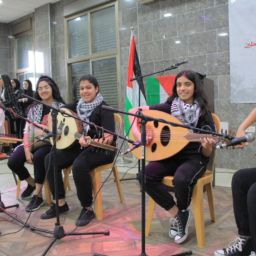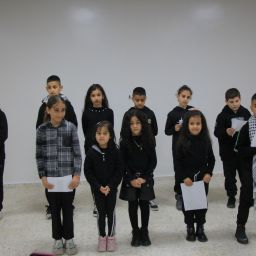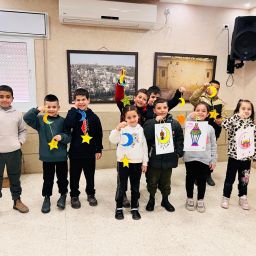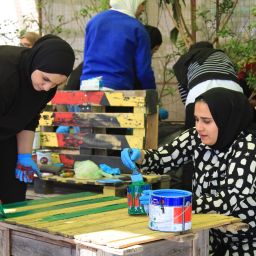Palestinian Kids Day 4/5/2022
Among the many rights of children which are practiced internationally and embodied in the Convention on the Rights of the Child, does not include Palestinian children, who are deprived of their most basic rights. Therefore, the Lajee Center arranged activities for 80 children from Aida’s Preparatory School, between the ages of 6 to 8 years old. One of the rights that Lajee focused on is the right to play, which was hosted in the Lajee Center’s Playground for about two hours. The Palestinian Kids Day activities included many sports and competitions between groups which allowed children of the Aida Refugee Camp a space to express their rights that had been taken away from them by the occupation that restricts freedom of movement and safety. Under the slogan of the people of the neighborhood, Restore the House and the Hook, which is the slogan of this year’s reading week that comes in cooperation with the Tamer Foundation of Community Education, many activities were implemented for library visitors, which included the following:
- Making of Qalayet Bandora (a traditional Palestinian saucy dish made with tomatoes, onions, and peppers in a frying pan) which was done jointly between 20 parents and children
- The children and parents were invited to attend the reading and discussion of a story titled “Haret Al-Tayeb”, during which we started with an activity before reading the story. The first activity was to the drawing of your dream home, where children were asked to draw the house they wished to live in. After they were finished, the children were asked questions about their dream homes and the neighborhood in which they would live in as well as their favorite foods. Then, the children were divided into 3 groups to discuss more about their homes and favorite dishes. Each group had a special name and special features and were given papers, which contained 6 hands/palms, with different topics on each palm.
- The following responses are from the Group “The Creators”:
- Favorite Foods: Maftoul (similar to Couscous), Stuffed Grape Leaves, Molokheya (similar to Spinach), Stuffed Turnips, Stuffed Zucchini
- Dream Home and Special Features: a room for my brother and I, a play room inside the house, a computer
- The Neighborhood: its colors and drawings on the buildings will distinguish it from other neighborhoods
- The following responses are from the Group “The Butterflies”:
- Favorite Foods: Macaroni, Stuffed Grape Leaves
- Dream Home and Special Features: a room to exercise in, my own room so I can keep it clean and organize it how I like
- The Neighborhood: peace and quiet, no apartheid wall, the smell of cake, the smell of Maklouba (“upside down” dish made with rice, and usually cauliflower and chicken)
- The following responses are from the Group “Alquds” (aka Jerusalem group):
- Favorite Foods: Stuffed Cabbage leaves, Stuffed Grape Leaves
- Dream Home and Special Features: a big kitchen, a big living room, my own bedroom
- The Neighborhood: a nearby school, a Masjid, a nearby store
After we finished reading the story, we asked the children to choose one of their favorite foods/dishes they listed in the first activity, and to list the ingredients:
- Maklouba: Rice, Angel Hair, Chicken, Spices, Salt, Oil, Eggplant, Cauliflower, Potatoes, and Chicken broth
One of our Kindergarten teachers, Maggie, who was also a participant with her children in the event, mentioned Qalayet Bandora as being her favorite and easiest dish to make. Qalayet Bandora has garlic, olive oil, salt, hot green peppers, and tomatoes. Another way to make it is with tomatoes, olive oil, salt, black pepper and possibly ground beef. After the discussion, we decided to make Qalayet Bandora and began cutting the tomatoes with mothers who participated with us in the event. We made Qalayet Bandora both ways so everyone can try and made enough for the entire group. We cut lettuce and cucumbers on the side along with olives. The children and the parents ate the tomato dish together, and the children expressed their enjoyment of the dish, which was a very interesting activity for them to be a part of.
The next Lajee Kids Day activity was held in the Jabal Al-Fardis area, in which 10 children were recognized and joined in the hike. The children learned about the history of the area and watched a movie about making houses out of wood. There were also games and Dabka with other library groups who joined and participated in the same hike.
The last interactive activity was called Home: the path to home. In this activity, 14 children participated. Many things can be learned on this path, that will make us more mature and wiser, and realize that this road will lead us home; home which is our home in this great country. This was the introduction to the group activity. After which, we asked the children what their thoughts were about home in respect to the introduction statement. We passed out papers that had pictures of different houses and important sites from all over the world and asked them to discuss what they felt and thought about these homes in comparison to the homes they know and see in Palestine. Some of these homes are boats, some are long, some are short, and some are shaped like a shoe. Then, we asked the children “which is more beautiful, the road leading to the house or the house itself?”, and opinions differed between them. One girl named Layan, answered “The house is more beautiful because the road takes me to my home, and I only see the Apartheid Wall”.
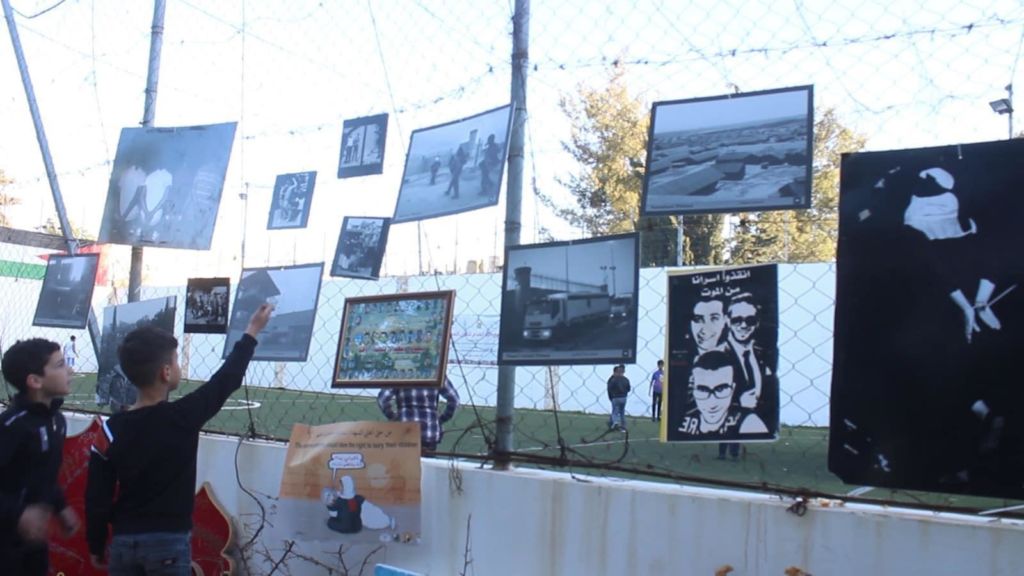
Another girl, Rowand, replied “The road is more beautiful because I see trees and hear the sound of birds chirping, but the house is also beautiful because its quiet and peaceful”. The next question asked was “What makes Aida Refugee camp different from other refugee camps in Bethlehem?” The answers differed in that some mentioned the different schools, the Key of Return at the entrance of the camp, and the Lajee Center and the Health Center. The negative aspect the children pointed out as being a major difference from other camps is the constant tear gas attacks and that the Apartheid Wall being so close and always infant of them and how they would like to see what is behind it.
Afterwards, the children were split into two groups, each group constructed a house made of wooden sticks and a cardboard box. The first group built their house to make it look like a hut and has an empty area around it. A boy named Laith said, “We built a house and it has a front and backyard area so we can play and spend time with others in it.” The second group built their house out of cardboard with the sticks laying on top in parts. They said they built it this way so they can look up from the roof of their home and see the stars and the sky. They also built an area surrounding it with a garden filled with mint. In this activity, we were able to provide the children with the space to explore their imagination and build the dream homes they wish to live in instead of their homes in the refugee camp which is contiguous to the Apartheid Wall.


